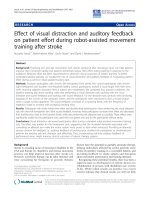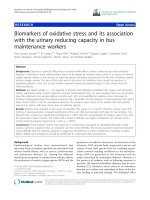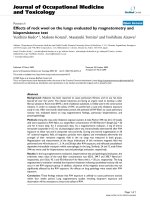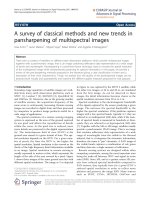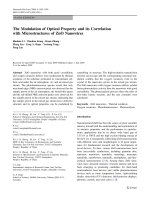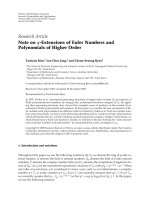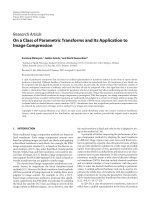On the possibility of visual literacy and new intentions with digital images an engagement with the discrete image by bernard stiegler
Bạn đang xem bản rút gọn của tài liệu. Xem và tải ngay bản đầy đủ của tài liệu tại đây (697.36 KB, 138 trang )
ON THE POSSIBILITY OF VISUAL LITERACY AND NEW
INTENTIONS WITH DIGITAL IMAGES
: AN ENGAGEMENT WITH ‘THE DISCRETE IMAGE’ BY BERNARD
STIEGLER
USHA MANAITHUNAI NATHAN
(B.ENG.(HONS)),NUS
A THESIS SUBMITTED
FOR THE DEGREE OF MASTER OF ARTS
DEPARTMENT OF ENGLISH LANGUAGE
AND LITERATURE
NATIONAL UNIVERSITY OF SINGAPORE
2011
Nathan 1
Acknowledgements
I am thankful for the inspiration of my supervisor Ryan Bishop that has made this
effort possible. This work is sustained by his guidance and example. The teaching of John
Phillips has been invaluable to my understanding of important works in critical theory
and the philosophy of Bernard Stiegler that has grounded my research.
The thesis owes to the involvement of a friend who undertook to read in parallel
with me, discuss my research and read the many versions of this thesis over the course of
more than a year that it has taken to complete this. The stimulating process of this mutual
engagement gives the aspirations of this thesis.
The abiding faith and support of many loved ones has provided the basis for the
persistence that this work has demanded.
Nathan 2
Contents
Introduction……………………………………………………………………..…………5
Chapter 1: A Reading of ‘The Discrete Image…………………………………………..12
Chapter 2: Technicisation in Context: Brain Science and Consumer Reality…………...38
Chapter 3: Modern Technics and the Possibility of Visual Literacy…………………….72
Epilogue………………………………………………………………………………...106
Works Cited…………………………………………………………………………….121
Nathan 3
Summary
In this thesis, I address Bernard Stiegler’s text ‘The Discrete Image.’ I analyse its
key argument that a new visual literacy is given by digital technology and that consumers
of images will be able to critically apprehend images and even synthesise new ones.
Stiegler argues that the inscription of images with discrete units or pixels implies the
possibility of reading and analysing images in the same way that writing made speech
and thought analysable. I suggest that Stiegler’s arguments for these future possibilities
of digital technology are based on a general process relating man and technics that he
conceives. This is the process by which all technics open future possibilities by
constituting the past and rendering it accessible. With digital technology formal and other
regularities of the visible world (and images) are constituted and this results in the
possibility of a new kind of perception.
But if we consider the contexts of consumer society and the history of digital
technology the massive impediments to the realisation of such possibilities come to light.
The mediated realities of the consumer world are not only targeting behaviours, but are
more actively altering the fundamental human faculties of attention, perception, thought
and memory. As a result of which the facts about humans may well have changed
rendering Stiegler’s hope for human visual intelligence untenable.
On the other hand, technologies of the post-War era come inscribed with the
language of control and visions of closed worlds suited for control and total
predictability. One consequence of which is that the design of modern technology betrays
Nathan 4
a unilateral focus on total automaticity. I contend that this history of technology can be
seen as giving the possibility of Stiegler’s own thinking on technics and their selfevolving status. But the same however does not fare well for the hope that such
technology will yield new perceptual possibilities for humans. I argue that in relation to
both the contexts mentioned of humans (consumers) and technology today the
possibilities of digital technology that Stiegler conceives appear implausible at best.
In the epilogue, I propose a mode of artistic creation as a means of achieving a
transformed perception and visual literacy. Techne in Heidegger’s sense or the productive
act of poesis (creation) names this modality in which the human surpasses the knowledge
of his time, fulfills the debt of the past and in doing so opens up future possibilities.
Nathan 5
Introduction
In 1997, IBM's custom built chess playing supercomputer Deep Blue defeated the
reigning world Champion and one of the greatest chess players of all human history,
Garry Kasparov. This was heralded by many as the birth of an era of superior artificial
intelligence and a historic triumph of machine over man. This supercomputer could
calculate 200 million possible moves on the chess board every second.1 Notably, this was
double the capacity of the first model of Deep Blue that Kasparov had defeated the
previous year.2 The new improved version was carrying out brute number crunching to
search as thoroughly as possible and match accordingly, with an advantage of speed. Not
surprisingly, Deep Blue’s searches included moves that would not even be considered by
a novice chess player. A member of the team that built Deep Blue explained that the team
had spent a year letting the machine repeatedly suffer defeat at the hands of another chess
grandmaster. The mistakes made in each of these defeats were painstakingly fixed in a
process that, he admitted, was “a bit clunky.”3
This is also the kind of exhaustive if unremarkable labor expended in the creation
of digital images. Images cannot be rendered from discrete numerical values without the
work of calculating the “overdetermined” set of relations each pixel bears to at least eight
1
2
3
Patricia A. Carpenter and Marcel Adam Just, “Computational Modeling of High-Level Cognition versus
Hypothesis Testing, The Nature of Cognition, ed. Robert J. Sternberg (Cambridge: MIT Press, 1999)
248.
Ibid.
David B. Fogel, Evolutionary Computation: Toward a New Philosophy of Machine Intelligence, 3rd ed.
(New Jersey: The Institute of Electrical and Electronic Engineers, 2006) 10.
Nathan 6
of its “neighbors.”4 This is “what makes images into images in the first place.”5 Any
algorithm that aims to filter, process or recognise objects in a digital image has to resort
to similar computations. It is no wonder that building up images from pixels is described
as “slow, time-consuming and often unnecessary.”6
In ‘The Discrete Image,’ Bernard Stiegler argues that consumers will soon be able
to critically and analytically access images as a result of digitisation. For Stiegler, the
inscription of images with pixels - a kind of alphabet of the visible world - implies the
possibility of describing various forms, objects and other regularities that occur in
images. Spectators will as a result be able to read and apprehend such regularities in the
images and the visible world. And since reading implies the ability to write they would
also be able to synthesise new images. The analysis of digital images using various
algorithms and software will also have epistemological consequences for sciences and
arts and these in turn will revolutionise visual literacy.
But the analysis and apprehension of the visual world in relation to its formal
aspects, the transformation of perception and the articulation of new intentions have long
been the prerogatives of visual art. Artists seek to inscribe the visible world with modest
tools such as brushes and make it available for analysis and synthesis through their
inscriptions. The question to be asked is - why one needs an unwieldy and largely
unintelligent mechanism for achieving the ends of art?
4
5
6
Friedrich Kittler, "Computer Graphics: A Semi-Technical Introduction," The Grey Room 2 (2009) 34.
Ibid.
Steve Jones, ed., Encyclopedia of New Media: an Essential Reference to Communication and
Technology (California: Sage, 2003) 1964.
Nathan 7
It is not incidental that ‘The Discrete Image’ was written and given as an address
to art students and artists who could appreciate the idea of visual literacy. The appeal of
Stiegler’s propositions is undeniable for his audience and for the rest of humanity. And
yet his arguments seem to unproblematically repeat technological claims about
digitisation without critically considering their actualities. Proclamations of the superior
intelligence of Deep Blue similarly overlook the workings of the supercomputer and the
nature of its intelligence. In the absence of such considerations, Stiegler’s text is too
easily aligned with the rhetoric of technology evangelists and their optimistic hyperbole
of an enlightened techno-given future.
A philosopher of considerable and growing influence in Europe as well as the
English-speaking world, Stiegler is widely read in disciplines such as critical theory,
cultural studies, technology and media studies. As an intellectual activist Stiegler has
consistently addressed issues pertaining to human culture and knowledge in light of new
technologies and its implications. His establishment and initiation of institutions such as
Ars Industrialis and the Institute for research and (technological) innovation in the Center
Pompidou in Paris further testify to his commitment to these issues. In his life and
thinking Stiegler continues to confront the question of humanity in its relation to modern
technology.
There is perhaps a more important reason why I have felt compelled to consider
‘The Discrete Image.’ The need for a visual literacy and an intelligent means for
accessing images is perhaps most critical and urgent today when our perception is
grappling with an inundation of images. ‘The Discrete Image’ sets out the necessity of
such a visual literacy and offers a glimpse of its potency. The possibility of an intelligent
Nathan 8
and transformed perception is the key concern of Stiegler’s text but it is also one whose
discussion is precluded at the same time that it is stated, owing in part to the
overwhelming emphasis on technological possibilities. In this thesis, I aim to address this
possibility of visual literacy that is articulated in ‘The Discrete Image.’
II
Modern technologies inherit the legacy of the Cold War and its language of total
control, predictability and a concomitant “distrust of the human.”7 Contemporary
sciences including robotics, neuroscience, AI, and the vast field of computational
sciences have acquired a strong strain of this anti-humanism. For instance, in the building
of man-machine weapon systems and in computer systems design it is an accepted truism
that the “human” is the weakest link. And systems are often built with the intent of overriding human faculties in the interest of securing the best results. Digital technology
partakes of this particular history of technology.
The mass dissemination of digital technology occurs in the 1990s. This is the
same decade when ‘The Discrete Image’ is written. This is also the context in which
neuroscience comes to prominence with the 90’s being designated as the ‘decade of the
brain.’ Meanwhile findings of psychology and the new brain sciences are being
instrumentally applied to media and advertising with ever greater effect and
7
Norbert Weiner, Invention: The Care and Feeding of Ideas (Cambridge: MIT Press, 1993) 89.
Nathan 9
systematicity. Aided with the potent ubiquity of digital technologies and the incisive
findings of cognitive science, contemporary media industries are quite literally waging a
war for the attentions and emotions of consumers.
Contexts such as these have a direct bearing on the discussion of ‘The Discrete
Image.’ In this thesis, I consider different scenarios of consumer society and the context
of the historical development of modern technology in order to situate and study
Stiegler’s propositions. For instance, Stiegler contends that technics provide humans with
new possibilities by rendering the past accessible. Writing records the flow of speech.
Such a return of the past addresses the reader through a book for instance and allows him
to analyse the writer’s thought and even synthesise new ones. Websites like Youtube
today offer recommendations or options - videos and other consumer goods, to users that
are based on the past visits of the specific user that have been recorded and analysed for
regularities by a software program. The program accesses the past and synthesizes new
options based on the analysis of this past. Such juxtapositions of scenarios with Stiegler’s
proposals serve two purposes in my analysis. They expand the understanding of
Stiegler’s terms by extending them in other directions. And they reveal the limitations of
Stiegler’s arguments for digital technology presented in ‘The Discrete Image.’
The structure of this thesis is such that it begins and culminates with a discussion
of the terms and key arguments of ‘The Discrete Image.’ The first chapter provides a
close reading of ‘The Discrete Image.’ It establishes the terms of the discussion that are
opened up and explicated in the course of many departures from the text in chapters 2 and
3. In the epilogue, I revert to the question of visual literacy posed by ‘The Discrete
Image’ to offer a positive account of how it may be realised.
Nathan 10
III
In the first chapter of the thesis, I explain Stiegler’s key argument in ‘The
Discrete Image’ with respect to a general process that relates man and technics and which
is at the core of Stiegler’s philosophy. This process, I argue, provides the basis for
conceiving the hopeful future for contemporary digital technology. Technics are
conceived by Stiegler as the means by which the past (speech, sound, gesture, experience
and knowledge) is both constituted and transmitted over time. And human possibilities
(future) are given in advance and over-determined by technical processes such as writing
that inscribe and transmit the past. Technics, in Stiegler’s understanding, give us our
heritage and our hope for a future by the same token. This process of the giving of the
past and of the simultaneous over-determination of future possibilities by technical
processes is what I call technicisation.
The second chapter juxtaposes this concept of technicisation alongside the
rhetoric of the brain sciences and scenarios from the contemporary consumer world. I
choose these because of their contextual relevance and because they share certain tropes
that are well aligned with Stiegler’s conceptions. The resulting comparisons bring to light
some of the problems with Stiegler’s discourse and his overweening optimism about
digital technology. In the third chapter, I compare Stiegler’s conception of technics with
the form of post-war technology. This reveals the conditions and inscriptions that may
have (over) determined Stiegler’s terms and conceptions. A brief, selective history of
technology in the post-War era is also used to illustrate further problems with the
realisation of the possibilities of digital technology that Stiegler puts forward.
Nathan 11
In the epilogue I consider the possibilities of new intentions, transformed
perception and visual intelligence. I propose how these could come about through a
particular mode of artistic creation that surpasses the limits and structures of one’s time
while realising the debt of the past.
The summative argument presented here is that though the possibility of a new
intelligent and critical perception is theoretically undeniable, it is not one that will be
granted by digital technology itself. And the process of tehcnicisation by which such an
outcome would come about may itself have been rendered obsolete by the overdeterminations of technology, human realities and mental worlds.
Nathan 12
Chapter 1: Stiegler’s ‘The Discrete Image’: A consideration of future possibilities
In ‘The Discrete Image’ Stiegler argues that spectators (or consumers) will soon
be able to critically and analytically apprehend images. Digitisation, he contends, is a
form of inscription akin to alphabetic writing with a “system of traces” or “discrete
elements” – pixels.8 And the alphabetisation or discretisation of images implies that
spectators will “read” and analyse images just as people read and understand books
(language) after writing had been invented.9
Stiegler proposes that in the place of the earlier relation to the analog photograph
in which the image appeared as a remnant of a past moment, digital technology provides
the possibility of analysing this past seen in a photograph. This analysis would be carried
out with various algorithms of image analysis.10 Through such analysis, Stiegler argues,
“(digitisation) opens the possibility of new knowledges of the image- artistic as well as
theoretical and scientific.”11 Significantly, the various knowledges about images would
inform the new visual literacy among spectators.12 In other words, knowledges produced
by image analysis would inform the spectators’ “reading” of images so that a new visual
“intelligence” will become possible.13 This is how the “gaze” of the spectator is said to be
transformed into one that is “more knowing” and “less credulous.” The above is the key
argument that Stiegler puts forward in ‘The Discrete Image.’
8
Bernard Stiegler, “The Discrete Image,” Echographies of Television: Filmed Interviews, trans. Jennifer
Bajorek (Cambridge: Polity, 2002) 162.
9
Ibid. 163.
10
Ibid. 161.
11
Ibid. 157.
12
Ibid. 162.
13
Ibid. 162.
Nathan 13
As consumers would be able to synthesise or create images of their own with
digital technology, Stiegler argues also that there is a real opportunity of modifying the
traditional opposition of ‘producers’ and ‘consumers’ in industrial societies.14 The
inscription of images with discrete elements implies both reading and writing capacities
that can convert passive consumption into active production. Digitisation would then
entail political possibilities of overcoming the consumer-producer divide through critique
(or reading) and through creation (or writing).
Stiegler contends that these analytical and synthetic possibilities are
fundamentally implied in the very nature of the digital photograph and the way that it is
produced. He suggests that digitisation allows for differentiated access to the newly
inscribed discrete elements (or pixels) of the image.15 Image analysis using algorithms is
possible because of this access. In so far as the analysis of digital images will follow
specific algorithms and the forms described in them, the “grammatical operator” of the
new visual literacy, or the operator that will describe and invent the grammatical rules of
reading images, is technology.16 For Stiegler then, not only is the possibility of the new
relation to the image technologically given (or implied in the nature of digitisation), it is
also going to be carried out in relation to conditions given by technology, particularly that
of computational analysis.
Crucially, Stiegler does not simply argue that the change in the spectator’s
relation to the image is possible, but that the “gaze” of the spectator “necessarily ends up
14
Ibid. 163.
15
Ibid. 154.
16
Ibid. 161.
Nathan 14
progressively transformed.”17 At the beginning of the text too, Stiegler states that he will
specify “what is happening” to the digital image and by the same token what is also
happening to the perceived image or the “mental-image” implying that changes in the
technologies that produce images necessarily entail changes in human perception.18 In
general, Stiegler conceives any technological change as the harbringer of new human
possibilities. This is a central premise of Stiegler’s philosophy.
Technics such as writing or photography, in Stiegler’s thesis, give the means by
which inheritances of a past (memory) are given. This inherited past indebts humans
beyond their autonomy and gives the conditions of their existence, their avenues of
knowledge and their possibilities of futures as well. In this way all technics create an
advance on human possibilities and are said to over-determine them. It is on the basis of
this process that Stiegler conceives new possibilities of perception or intelligent seeing as
given by digitisation.
In this chapter I will argue that the radical possibilities proposed in ‘The Discrete
Image’ are based on such a process that underlies the general relation between man and
technics in Stiegler’s philosophy. Firstly, I will explain how the relation of man and
technics in Stiegler’s thought is expressed in terms of the access to the past. Secondly, I
will show that the same relation also underlies that between the mental-image (or the
perceived image) and the image-object (the material counter-part) in ‘The Discrete
Image.’ And lastly, I suggest that the new kind of seeing given by digitisation also
derives from the same process of technicisation.
17
Ibid. 160. Emphasis added.
18
Ibid. 148.
Nathan 15
Before proceeding to outline the arguments that Stiegler proposes in the text, it is
useful to define the term ‘discrete image.’ Stiegler uses this term inter-changeably with
the phrase ‘analogico-digital image’ while referring to what is commonly understood as
the digital photograph. The term ‘analogico-digital image’ indicates the relation to the
analog predecessor of the digital photograph. This relation highlights the essentially
“orthothetic” aspect or the “exactitude” of recording that is common to both digital and
analog photographs.19 For Stiegler, orthothesis is inaugurated for the first time in history
with alphabetic writing that made the event of speech or language available in its ‘exact’
and immediately accessible form. The analog photograph also allows for such an exact
recording of light as the silver crystals of a photograph precisely capture it.20 Stiegler
argues that analog technologies, such as the photograph and the phonograph, can
“(reconstitute) much vaster levels of the past” (such as gesture, form, sound) than that
constituted previously by written or printed books.21 The access to the past inscribed and
thereby constituted by technics is fundamental to Stiegler’s argument.
Epokhe or suspension that Stiegler discusses in the text is also comparable to
orthothesis.22 In phenomenological terms, exact recording implies a “suspension” in “the
relation to time” and “to memory and death.” 23 Stiegler argues that such an orthothetic
process of exact reconstitution of the past is what the analogico-digital technology
“continues and amplifies.”24 The digital image does produce a lack of certitude about the
19
Bernard Stiegler, Technics and Time, 2: Disorientation, trans. Stephen Barker (Stanford: Stanford UP,
2009) 13.
20
Ibid. 13.
21
Bernard Stiegler, “Anamnesis and Hypomnesis,” Lecture transcript, Oslo. 2007. 13 April. 2010
<
22
Stiegler, The Discrete Image 149.
23
Ibid. 149.
24
Ibid. 149.
Nathan 16
image as “has-been” but digitisation creates a means of inscription with pixels that can
yield “libraries” of images, objects or elements of images and of various movements (of
the visible as well as unseen world). New knowledge and visual intelligence are possible
because of the new ways of constituting, and hence creating access to more aspects of the
past.25
1. Technics and man
Stiegler’s concept of technics incorporates the Greek concept of techne, which is
often mentioned in his texts and is sometimes used interchangeably with technics. Techne
denotes all practices (art) that require skill including crafts and fine arts. Techne also
referred more generally to any “reflected system of practices, notions and concepts,” in
ancient Greece.26 The term applied to a range of practices including the art (or techne) of
living and the art of governance. Stiegler implies from this that “all human action has
something to do with techne…”27 The inclusion of techne within the concept of technics
allows Stiegler to generalise technics to incorporate a wide range of practices and human
endeavours alongside technologies such as digital photography.
The creation and constitution of man himself, Stiegler suggests, is tied to technics.
The history of man as such is inseparable from the history of technics.28 Stiegler argues
that the history of man consists in the “pursuit of the evolution of the living by other
25
Ibid. 157.
26
Michel Foucault, The Hermeneutics of the Subject Lectures at the College de France 1981-
1982, ed. Frederic Gros, trans. Graham Burchell (New York: Palgrave Macmillan, 2005) 249.
27
Bernard Stiegler, Technics and Time, 1: The Fault of Epimetheus, trans. Richard Beardsworth and
George Collins (Stanford: Stanford UP, 2009) 94.
28
Stiegler, The Discrete Image 173.
Nathan 17
means than life,” which is to say means that are external to his biological being.29 This
pursuit refers to the creation of various forms of technics such as simple hand tools,
writing, painting, photography and other modern technologies. Stiegler states further that
technics are an intrinsic part of humans because man is defined by a lack of quality,
according to the Promethean myth. Instead he is endowed with technics with which he
can fashion tools and fabricate artifacts.30 Stiegler understands this lack of quality as a
lack of memory. He calls this “retentional finitude,” following Derrida and Husserl.31
Stiegler also suggests that human memory, or the access to a ‘past’ (that includes all
knowledge) is always and originarily exteriorised through technics and consigned to
traces or marks in the Derridian sense of the word. For the purposes of further discussion
I shall refer to this particular process of exteriorising memory as technicisation.
The trace or mark is also what is sometimes called différance in Derrida’s
philosophy. The term designates “the movement” through which “language or …any
system of referral” is “instituted.”32 The trace or différance constitutes or produces all
oppositions and dualities such as the signified and the signifier. The relation to time for
instance is created by the work of différance – the deferral that is also at once a
differentiation. The present is defined in relation to the past seen in the photograph from
which it is differentiated but this past is also experienced only through a deferral to a
future (which for the spectator is the present). This past seen in the photograph is that
which “… has been here, and yet immediately separated, irrefutably present, and yet
29
Stiegler, Technics and Time, 1 135.
Bernard Stiegler, “Technics of Decision: An Interview,” Angelaki 8.2 (2003): 156.
31
Stiegler, The Discrete Image 174.
32
Jacques Derrida, “Différance,” Margins of Philosophy, trans. Alan Bass (Chicago: U of Chicago P,
1984) 12.
30
Nathan 18
always deferred.” 33 All differences are produced by such simultaneous spacing and
deferral. The differences themselves are effects of this movement or play of différance.34
This movement then is the basis of all concepts.35 The trace, mark or différance – the
movement that produces differences and conceptuality is writing. Writing here is not
writing in the notational and literal sense of the word. It denotes the process of inscription
understood in its most general sense. Derrida states that the meaning of trace (of writing
in this broad sense) extends beyond the verbal sign and human language itself.36
Stiegler contends that that which specifies différance itself is the exteriorised
memory created using technics. This memory, he states, is the provenance or the “central
concept” of différance.37 The movement that produces all differentiation, he argues, is
produced in the process of exteriorisation of memory. Stiegler describes this
exteriorisation as “the recapitulating, dynamic and morphogenetic...accumulation of
individual experiences.”38 Technicisation, following these considerations, can be defined
simply as the process of inscription by which individual experiences and knowledge are
articulated and hence made available. Inscription here retains the importance of writing in
the formation of the trace in Derrida’s philosophy.
Stiegler’s notion of the exteriorisation (of memory) through technics also
appropriates the concept defined by the Greek term hypomnesis.39 The word signifies
33
Roland Barthes, Camera Lucida: Reflections on Photography , trans. Richard Howard (New York: Hill
and Wang, 1982) 77, quoted in Bernard Stiegler, Technics and Time, 1 20.
34
Derrida, Difference 10-12.
35
Ibid.
36
Jacques Derrida, “My Chances/Mes Chances: A Rendezvous of Epicurean Stereophonies,” Psyche:
Inventions of the Other, Volume I, trans. Irene Harvey and Avital Ronell, ed. Peggy Kamuf and
Elizabeth Rottenberg (Stanford: Stanford University Press, 2007) 360.
37
Stiegler, Technics and Time, 1 178.
38
Ibid. 177.
39
Stiegler, Anamnesis and Hypomnesis.
Nathan 19
“aids to memory.”40 The term refers simply to “a collection of quotations or things in the
form of notes” or it might designate “any commentary or form of written memory,” kept
by a person.41 These notes are said to be “for use of oneself” but they were also useful for
others.42 It has been noted that ancient Greek philosophers shared their hypomenata with
disciples and others in need of advice.43 These notes were for “future use” (eis husteron)
and they were created as “equipment” (paraskeue) that could be used in various
circumstances.44 The creation of these notes allowed subjects to reread what was written
at different times and in this way the contents of the notes could be “reactualized.”45 This
concept of hypomnesis includes the relation of memory to writing, the creation of
knowledge through a technique and the access of this knowledge at a later time, all of
which are important to Stiegler’s concept of exteriorisation. Stiegler generalises this
particular practice of note-keeping specific to Greek thought and applies it more
generally to all forms of technics. He writes for instance that the “Internet is the age of
the hypomnesis.”46
By borrowing the enabling dynamism of différance for technics and generalising
a particular Greek process, Stiegler infers that all concepts, all distinctions and all
knowledge are given by technicisation. Stiegler also specifies certain stages of the said
human “evolution” through technics. The earliest forms of technics were flaked
pebbles.47 These, Stiegler observes, are not explicit memory stores but the “possibility of
40
Foucault, The Hermeneutics of the Subject 360.
Ibid. 369.
42
Ibid. 360.
43
Ibid. 369.
44
Ibid. 367.
45
Ibid. 500.
46
Stiegler, Anamnesis and Hypomnesis.
47
Ibid.
41
Nathan 20
transmitting knowledge acquired individually, but in a non-biological way” is opened up
with their appearance.48 Later with alphabetic writing, for the first time, mnemotechnics
appear and this creates a means of constituting the past (memory) and of transmitting it.
With analog reproducibility and technologies such as analog photography, phonographs
and machines that reproduce the gestures, movements of men, “mnemotechnologies”
appear.49
With regards to the relation of man and technics, Stiegler applies the concept of
différance to critique the opposition of the two in metaphysics and philosophy. He argues
that in the place of this opposition of man and technics one needs to see a co-constitution
through the movement of différance. But since différance in Stiegler’s thinking is itself
produced by processes of technical inscription, both man and technics are constituted by
technicisation. This is summed up in “…the appearance of the human is the appearance
of the technical…the human invents himself in the technical by inventing the tool- by
becoming exteriorised techno-logically.”50 Stiegler in this way reconciles the
metaphysical duality of man and technics by proposing a condition of ontological priority
where technical processes constitute man and his possibilities.
In conclusion, Stiegler conceives of technics as an intrinsic part of the human
constitution in so far as the human has a limited memory. From here, Stiegler goes on to
argue for the radical possibility that all human skill and knowledge is given by
technicisation- the process of exteriorising memory. This process is simply any means of
48
Ibid.
49
50
Ibid.
Stiegler, Technics and Time, 1 141.
Nathan 21
inscription that is given by technics, such as writing and photography, through which the
past is constituted and made accessible as a dynamic store of memory.
2. Motif of the Specter
The motif of the specter, in Stiegler, outlines how the “past” that is given by
technicisation defines human conditions and gives human possibilities in advance. This
reveals how new technics may yield the possibilities outlined in ‘The Discrete Image.’
The past given by technics is one that has not been lived but which appears as a
“spirit,” a ghost (revenant) or specter. Barthes speaks of specters in his discussion of
analog photography. The specter or the ghost is also an important part of Derrida’s rethinking of the notion of ‘presence’ in philosophy. In the place of the self-evidence of
presence Derrida argues for the importance of revenants- the returning past(s) at the heart
of the present that cannot be banished. In this sense the spectral logic is the logic of the
trace or différance.51 The specter also surfaces in the work of Heidegger and his
philosophy of being. Heidegger, Stiegler notes, brings the question of “heritage” – or an
unlived past, to philosophy for the very first time.52 The specter in Stiegler’s conception
draws on the work of all these three thinkers. An important difference however is that
Stiegler argues that specters are transmitted by technics.
51
Jacques Derrida, “Spectrographies,” Echographies of Television: Filmed Interviews, trans. Jennifer
Bajorek (Cambridge: Polity, 2002) 117.
52
Stiegler, Technics and Time, 2. 4.
Nathan 22
Barthes speaks of the ‘referent’ of the analog image as the “spectrum of the
photograph.”53 The word spectrum “retains” the concept of a spectacle or a kind of vision
and adds to it the implications of a ghostly return of a (dead) past.54 The ghostly aspect of
the presentation of the photograph is crucial for it is in this sense that Barthes speaks of
“emanation” - the analog photograph, he states, is an “emanation of the referent. 55” This
means that it is constituted through the light that is reflected directly from the contours of
the person in front of the lens. In Barthes’ combination of spectacle and return, two
aspects of the returning past converge and give the condition of the spectator’s
captivation beyond any possibility of “escape.”56
Derrida too argues that this returning past does not permit any reciprocal response
from the viewer.57 He uses the term ‘visor effect’ for the gaze of the past that concerns
the one who is watched and which addresses him.58 Stiegler describes this condition in an
instance in the text where he describes his seeing of the photograph of Baudelaire and the
effect of being “touched” by the ghost of the dead poet but of not being able to touch him
in return.59 ‘Past’ that is seen in a photograph, read in a book or accessed through any
inscription, creates a situation of incommensurability in both Derrida’s and Barthes’
thinking.
For Stiegler, specters appear through inscription or technics such as writing. The
‘spectrum’ in Stiegler's revision of the Barthesian concept becomes the “revelation” of a
53
Roland Barthes, Camera Lucida 9.
Ibid. 9.
55
Ibid. 80.
56
Ibid. 90.
57
Derrida, Spectrographies 120.
58
Ibid. 120.
59
Stiegler, The Discrete Image 152.
54
Nathan 23
“chemical reaction on photo-sensitive film.”60 The conjunction of the ghostly appearance
of a past in the present is given in the interfacing of the optical system of image-capture
and the chemical reaction that reveals the image to the spectator (in his present).61 The
ghost that Derrida defines as an inheritance or a debt becomes in Stiegler's formulation a
product of technics in this manner. It follows then that the specters of the past, that
address the spectator while also surpassing him, are given by technics and made possible
by the inscriptions of technicisation.62
The specter however is not only of that which comes before but it is also that
which is yet to come. Barthes writes about the old photograph of the young Lewis Payne
taken moments before he is to be hanged. He reads in this picture both- ‘he is dead’ and
that ‘he is going to die.’63 The photograph not only gives Barthes the pose of the absolute
past but also speaks of the “death in the future.”64 Stiegler conceives of this as a
mirroring that produces the relation of the self to itself and its relation to time. The
spectator, Stiegler argues, sees his own death “coming into view” in the simultaneous
experience of the past and the future deaths.65 The photograph opens the space between
“here and there,” “past and future” creating the very basis for temporalisation.66 The
photograph in its two-sided relation to time also reveals the work of anticipation- the
relation to future. Stiegler argues that “technologies” that transform our relations to the
60
Stiegler, Technics and Time, 2 15.
Ibid.
62
Stiegler, Technics of Decision: An Interview 154.
63
Barthes 96.
64
Ibid.
65
Stiegler, Technics and Time, 2 17.
66
Ibid.
61
Nathan 24
past, also give us our new relations to the future.67 This condition is explicated stated in
the opening remark of his book Technics and Time,1: “The object of this work is technics
apprehended as the horizon of every possible future possibility and every possibility of a
future.”68
Derrida too argues that the ghost of the “wholly other,” or that of the past is
inheritance.69 This inherited past always “exceeds…infinitely and universally” the one
that comes after.70 It denies him any “absolute autonomy.”71 But at the same time, the
specter is also that which grants autonomy. It is a “condition of freedom,” as freedom
stems from “this responsibility” born in “the eyes of the other.”72 This implication is
crucial for Stiegler too, for it outlines the condition of opening up of new possibilities that
occurs with spectral returns- that they only arise from the debt or advance created by the
past.
We may recall here that for Stiegler through each new form of technics, and with
the analogico-digital technology in ‘The Discrete Image’ too, the past that is available is
amplified which greater possibilities of relating to the future. The notion of “reflexivity”
in ‘The Discrete Image’ encapsulates the possibility both of reflecting on the past and of
anticipating and reflecting on the future.73 In other words, having access to greater stores
of the past implies new ways in which the future can be imagined, anticipated and
prepared for.
67
Bernard Stiegler, “Phonographies” Echographies of Television: Filmed Interviews, trans. Jennifer
Bajorek (Cambridge: Polity, 2002) 102.
68
Stiegler, Technics and Time, 1 1.
69
Derrida, Spectrographies 121.
70
Ibid. 121.
71
Ibid. 122.
72
Ibid. 122.
73
Stiegler, Discrete Image 162.


